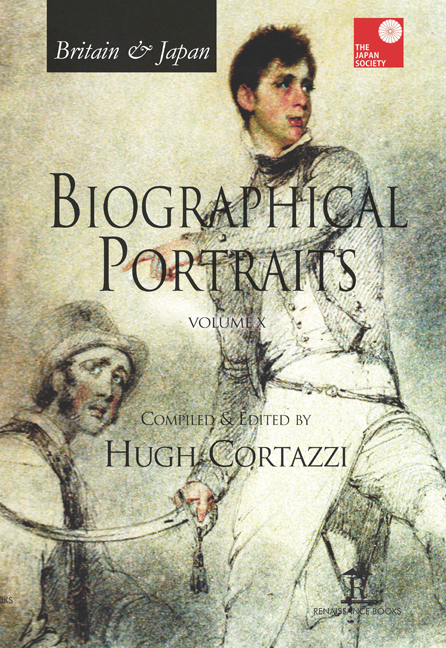Book contents
- Frontmatter
- Dedication
- Contents
- Introduction
- List of Contributors
- Index of Biographical Portraits in Japan Society Volumes
- PART I BRITAIN IN JAPAN
- PART II JAPAN IN BRITAIN
- Select Bibliography of Works in English on Anglo-Japanese Relations [Compiled by Gill Goddard – Retired East Asian Studies Librarian, University of Sheffield]
- Select Bibliography of Works in Japanese on Anglo-Japanese Relations [Compiled by Akira Hirano, SISJAC]
- Index
63 - The Royal Academy of Arts and Japan: 140 Years of Exhibitions, Education and Debate
Published online by Cambridge University Press: 07 May 2022
- Frontmatter
- Dedication
- Contents
- Introduction
- List of Contributors
- Index of Biographical Portraits in Japan Society Volumes
- PART I BRITAIN IN JAPAN
- PART II JAPAN IN BRITAIN
- Select Bibliography of Works in English on Anglo-Japanese Relations [Compiled by Gill Goddard – Retired East Asian Studies Librarian, University of Sheffield]
- Select Bibliography of Works in Japanese on Anglo-Japanese Relations [Compiled by Akira Hirano, SISJAC]
- Index
Summary
INTRODUCTION
THE ROYAL ACADEMY of Arts was founded in 1768, and is an independent, privately funded institution, led by eminent artists and architects. Its purpose is to promote art and artists through exhibitions, education and debate. This essay explores the ways in which the academy has engaged with Japan over the last 140 years, from the first unveiling of an oil painting by a Japanese artist at the Summer Exhibition, to the recently completed touring exhibition of the Royal Academy's own collections in Japan.
PIONEERING STUDENTS OF ‘BARBARIAN ART’
Japanese-British exchanges in art began in the 1860s. The earliest contact between Japan and the Royal Academy was in 1876, when an oil painting by Hyakutake Kaneyuki (1842–1884) was exhibited at the Royal Academy's Summer Exhibition.
Hyakutake was the first Japanese to have exhibited at the Summer Exhibition, but also the first ever Japanese to have had an oil painting displayed at an overseas exhibition. But Hyakutake was not an artist by profession. He was a close companion and aide to the last head of the Saga domain in Kyushu, Nabeshima Naohiro. Through the powerful clan's networks, Hyakutake had the opportunity to study what would have then been called ‘barbarian painting’ techniques and was initially said to have been taught the use of oil with Gottfried Wagener, a technical adviser to the Saga clan in 1870.
In an effort to spur Japan to modernize and catch up with the West, the Meiji government had dispatched hundreds of students to Europe and America. The fifth and last article of the Charter Oath of 1868 declared that ‘Knowledge shall be sought throughout the world so as to strengthen the foundations of Imperial rule’. The Meiji government fully expected the students to grasp and introduce elements of Western civilization to Japan.
Having been selected to depart on a tour of Europe with Nabeshima Naohiro, Hyakutake left with the Iwakura Mission and eventually reached London in 1872. He studied English together with Nabeshima, and then went on to read economics at Oxford University as one of the first Japanese students to have been accepted there. When Nabeshima's wife, Taneko, took up painting with Thomas Miles Richardson Jr in 1875, Hyakutake accompanied her to the lessons where he continued to study Western-style oil techniques.
- Type
- Chapter
- Information
- Britain & Japan Biographical Portraits Vol X , pp. 718 - 730Publisher: Amsterdam University PressPrint publication year: 2016



